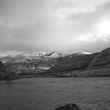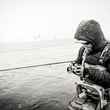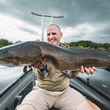His confusion increased until late in his teens when while sitting in the woods staring at a river in the spring two migrating warblers had landed on him. At that point he decided that birds had to be angels and felt blessed.
A riddle wrapped in an enigma, the Sand Country streams of Central Wisconsin—not quite spring creeks but not classic freestoners, either—pose some of the most difficult brown trout fishing in the world.
The only time you can really get the upper hand on these fish is during a hatch of Hexagenia, the giant nocturnal mayfly that comes off for a couple weeks in June. That’s when, emboldened by the darkness, even the biggest, most reticent browns shed their inhibitions, emerging from the woody snags and undercut banks to surface-feed with orgiastic gusto. The writer and angling travel pioneer Jim Chapralis once turned down an invitation to attend a private party at the Playboy Mansion in Chicago because he’d gotten word that the Hex hatch was going hot and heavy.
As he put it in Le Shack, his charming memoir of trout fishing in Central Wisconsin, that was a sign of either “real addiction—or insanity.”
On this intermittently sunny afternoon in May, however, I was pinning my hopes on black caddis—on this Sand Country stream, about the only other bug that comes off in sufficient numbers to bring up fish. In 20 years of fishing here, I’d found trout rising to something other than caddis or Hex exactly once.
More Like This
Early one evening I came upon a riffle that sulphurs were popping out of like corks, and below it, where the current necked down to create a natural funnel, a pretty good fish was slurping away. I finally managed to fool him and when he felt the hook he rocketed out of the water like a Polaris missile. Chapralis thought that these Central Wisconsin trout were the jumpingest browns on the planet (his friend A.J. McClane supposedly held the same opinion) and I’m inclined to agree. This fish, a handsome 14-incher, went airborne multiple times before I was able to bring him to hand.
It’s enough to make you wonder if there wasn’t a little salar mixed in with whatever strain of trutta they planted way back when.
But that, as I said, was a one-time thing. And now the caddis I was hoping for weren’t materializing. Something was happening, though, because now and again yellow-rumped warblers were diving from their treetop perches to pluck insects out of the air. Surgically precise and incomparably acrobatic, they were such masterful aerialists that, watching them, I had the semi-profound if not quasi-Biblical insight that warblers have no concept of what it means to fall.
Just what they were feeding on, however, remained an open question. Then, scanning the corridor of clear air above the river, I saw what looked like a flake of dark ash spiraling up—and at almost the same moment a yellow-rumped darted out to intercept it. A small, dark mayfly … Baetis? I’d seen a handful on this stream over the years, so that seemed to make sense.
But as I began seeing a few more, something didn’t fit the standard Baetis profile. The size was right—about an #18—but the color was subtly different. This fly was more of a uniform slate-gray, almost what I’d call gunmetal, without any trace of green on the body. Disbelief had its shoulder against the door, but the evidence was irresistibly strong.
The emergers were Iron Blue Duns.
Desperately rare. Mythically elusive. Objects of grail-like veneration among fly fishers since the days of greenheart rods and horsehair leaders.
I’d only seen them once before—on the Minipi in Labrador. Labrador! It had taken a while to figure out what kind of tiny fly those giant brook trout were sipping but once we did the fishing turned magical. Or maybe preposterous, when you measure “normal” trout fishing against the idea of catching four- and five-pound brookies on #18 dries.
I had no explanation for why Iron Blue Duns were hatching here; I could only assume it was one of those anomalous phenomena, like that one-off sulphur
hatch, that all of us who splash around in trout streams witness from time-to-time—and hope we’re in position to take advantage of.
There weren’t a lot of duns coming off, but there were enough to stir up a few rises—each of which, it seemed, forced me to draw a different arrow from my quiver. It was as if the gods were administering a final exam, a practicum of small-stream dry fly skills. I disinterred a Catskill-style imitation from a seldom-visited box, knotted it to a 6X tippet, and went to work.
The first trout I fished to was rising in a glassy basin bracketed by faster current. I had to make a dead upstream cast, and after having my fly ripped out the moment it touched down I saw that I needed to shoot the cast high and long, check it, and let it fall with a pile of of slack—the only way to make the fly dawdle in the sweet spot. On my third try I got it right, and at the touch of the hook the trout came skipping out of the water like a sailfish. He proved to be a 12-incher, a good fish for banker’s hours and a fun tussle on a rod made of grass.

The next fish, rising tight to the bank just above a tangle of half-submerged brush, forced me to my knees. The cast was an exercise in applied vector mechanics: a low change-of-direction with a left-to-right draw. That was the only way to get the fly to work deep enough into the slot and even so it took multiple drifts to get the trout to eat. When he did, though, he did it with emphasis. He blew up on that fly.
The fish put himself on the reel in about a nanosecond and it was a minor miracle that I was able to steer him clear of the wood. At 15 inches (and thick through the middle to boot), he was about as nice a brown as I’ve ever landed here before the sun’s gone down.
Then there was a fish rising above a virtual tunnel of criss-crossing tree limbs. The only way to get a fly to him was by making a downstream check cast, so I crept out on a little point, and, crouching low, began working out line. When I felt that the length was right I snubbed the forward stroke and dropped the fly short. It drifted a couple feet and bingo! This fish was another jumper, and, at 13 inches, another dandy.
I was feeling pretty smug at that point and when I heard the galvanizing smack of a good fish feeding above the next bend I had every confidence I’d tack his figurative skin to the wall, too.
Well, we all know where pride goeth. The trout was rising in the middle of a tail-out. The current was uniform, I was able to stand in the water 35 feet below the fish, there were no issues with the backcast, I knew I had the right fly …
It should have been a no-brainer, but the only thing I did successfully was put the fish down. As if I’d suddenly developed some terrible wasting affliction, I couldn’t make the fly go where I wanted it to.
The gods, in their wisdom, had knocked me down a peg—and taught me a lesson that the warblers, still performing their aerial ballet and untainted by sin original or otherwise, would never need to know.






























Comments
Scott replied on Permalink
That's the fact Jack.
Pages